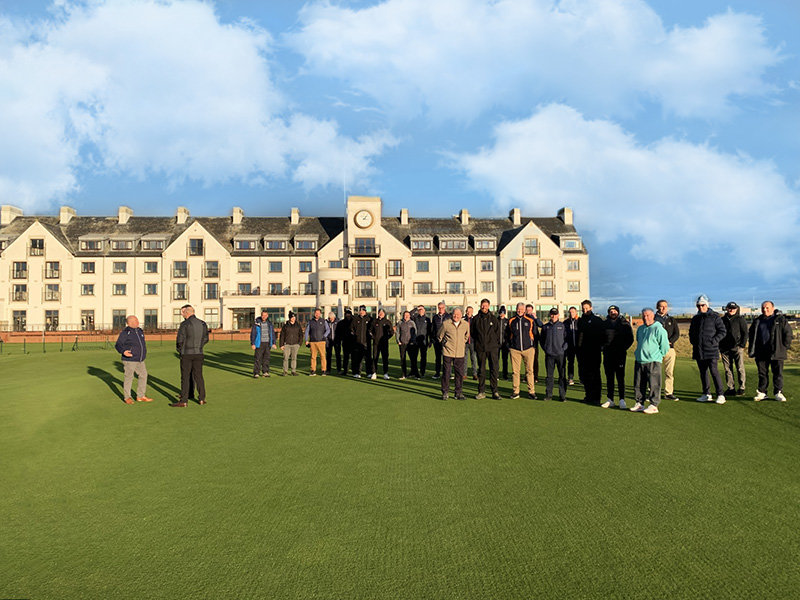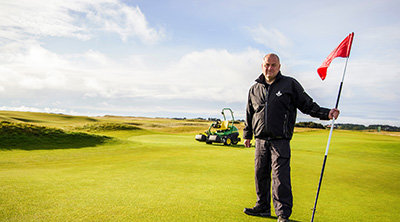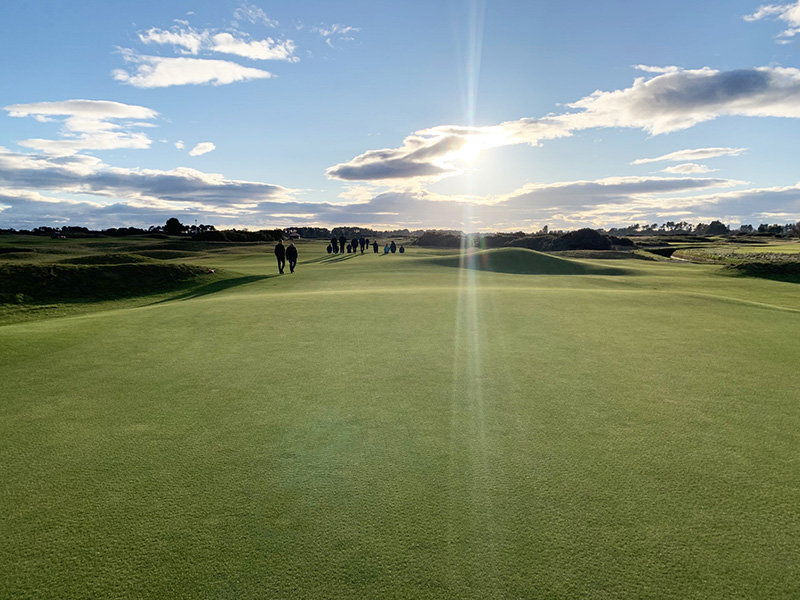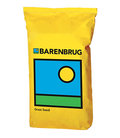Barnoustie launched at its namesake Carnoustie
November 2023 saw the launch of the latest in Barenbrug’s long line of market-leading slender creeping red fescue cultivars – Barnoustie.

November 2023 saw the launch of the latest in Barenbrug’s long line of market-leading slender creeping red fescue cultivars – Barnoustie.
Carnoustie, the world-renowned Angus links and home to the Championship Course, which has held eight Open Championships, two Women’s Open and two Senior’s Opens, played host for this special launch event after giving permission to use its name several years ago when the new grass variety was undergoing its trial and registration processes.

It was clear from a very early stage of the British Society of Plant Breeders (BSPB) trials at the Sports Turf Research Institute (STRI) that this grass was destined for great things – a natural successor to Barcrown, which will now be gradually phased out of production after a 30-year reign. It came as no surprise when Barnoustie was listed as the new #1 slender for Greens in the 2023 Turfgrass Seed booklet.
Course Managers from east-coast Scottish links courses were invited to attend the day, as well as some notable former Carnoustie servants such as John Philp MBE and Gary Johnstone, now overseeing Portmarnock Golf Club.

Kevin Stott, Carnoustie Links Superintendent, and Duncan Cairnie, Championship Course Manager, took delivery of the world’s first bag of Barnoustie certified seed production, and delivered a first-class course walk of the immaculate Championship Course. The agenda also included a talk on the Story of Grass (Barnoustie) from Dave Greenshields, Commercial Manager with Barenbrug UK, and a superb Q&A session with Kevin Stott, discussing their recent successful overseeding programme (see below transcript).
Barnoustie will feature in the 2024 formulation of Barenbrug’s market-leading FESCUE product, which will also contain two other new varieties, Barquess (slender) and Dancing Chewings, alongside recent #1-rated cultivars Barlineus and Barcrown.
Barenbrug would like to extend its thanks to Carnoustie Links for their involvement and endorsement in this historic occasion.
Overseeding Q&A with Kevin Stott, Carnoustie Links Superintendent


DG: Take us back a few years… What was the starting point for this overseeding process?
KS: We hosted the Open Championship back in 2018. I’m sure people can remember – it was a hot and dry summer, great conditions for links golf, but pretty stressful for the turf. We came through the week well, but managing the greens was far from easy.
At that point we had Poa-dominant surfaces – managing moisture and nutrition in the lead up to, and during the event, was a very fine balance, bearing in mind how we needed the greens to perform for the World’s best golfers.
As I say, we got through it very successfully, but I felt it was a perfect time to analyse things and change some fundamentals on how the greens on the Championship course were managed.
DG: So, the decision was to push hard for fescue overseeding. How did you communicate that to other stakeholders, and justify possible disruption to paying visitors?
KS: We are reliant on visitor golf, particularly the American tourist market during the summer playing season. Our Executive Team were supportive once they understood that the process would not impact playing quality to any great degree; everyone bought into the reasons behind the change. Ultimately, we all want Carnoustie to represent the best of links golf, and for me, that must include fine fast greens dominated by fine grasses – particularly fescue.
DG: Did maintaining high quality levels influence your choice of overseeding method?
KS: Certainly. We decided early on that a good quality dimple seeder set up right could do the job well. We wanted to create a seed bed of a very large number of small holes, rather than drilling the seed in lines or going down the route of fewer but larger holes. I am not saying those methods are wrong at all – they just didn’t fit with what we needed. We wanted to get large volumes of seed out in multiple applications during the playing season – and still maintain a good surface – that’s why we chose to go with a dimple seeder.
DG: Can you expand on more details of the method, application rates etc.?
KS: The advice from R&A agronomy and Barenbrug was very clear – high seeding rates would be key to accelerate the species conversion. My initial plan was to overseed at a moderate seeding rate of around 20 grams per-metre-squared frequently throughout the season, but after further discussion, we settled on a target of four applications at 30 grams.
We achieved that rate in 2019 and then Covid hit. We quickly re-evaluated budgets and unfortunately, the overseeding was viewed as non-essential. So, we only got one overseed done in 2020. When things had settled down and it was clear that tourism would restart in 2021, we hit them hard again, and again in 2022 and this year.
We spent a while experimenting with the seeder and figuring out how to get that volume of seed into the dimple holes quickly and effectively. After a while, we had it nailed down, but it’s a time-consuming operation with five guys in total. The green would be cut first to remove any moisture, dimple seeder would then go across the green, in areas we would double pass, but we would always switch the seed in before the second pass. The green would be rolled after, the seeded greens would also be rolled for the next two days to help seal the holes and aid ball roll.
DG: How flexible have you been in order to get the work done?
KS: Yeah, very. We haven’t stuck rigidly to a calendar or anything. If conditions are right, we will make a decision to get the seeder out. The surface needs to be dry ideally as moisture puffed up the seed and made it difficult to get down the hole. Too windy isn’t helpful but neither is flat calm – the seed doesn’t go down the holes without some air movement. Similarly, we haven’t been set on getting a certain number of greens done at any one time. Some days, we might only have time or the conditions to do a couple, and that’s fine.
So, I guess it has been a priority to hit that annual target, but flexibility and pragmatism has been the key to getting it done right.

DG: How much of a role did graminicides play?
KS: Not a huge amount to be honest. They were treated with Rescue a few years back to get rid of some straggly Highland bent. But during the overseeding process, no. We haven’t created a lot of space for the fescue – the greens have had full grass coverage in other words.
DG: Follow-up maintenance, in my opinion, is the final piece in the jigsaw and arguably the toughest bit to get right. Germination is easy, establishment is hard! From following your journey, I think this has been the biggest achievement and there have been some key take-aways worth sharing.
A critical bit, particularly with Fescue in sandy sites, is moisture management. Can you give us some of your thoughts on this?
KS: Yep, absolutely key. We have aimed for 20% moisture throughout the playing season, with the knowledge that at any time, there will be young fescue plants in the sward without developed root systems. And we have kept on top of it. This has made the greens fractionally softer on a daily basis, but still firm enough to keep golfers looking for links conditions happy. The wet summer of 2019 really helped us – good rainfall is a great tonic to young seedlings, and always superior to irrigation.
The other effect it has had is that organic matter (OM) has increased steadily over the last few years. We knew this would happen, and I think this shows the change of ethos we have had. Previously, we would have been more focussed on target levels for OM, moisture, and Clegg readings. We have relaxed this mindset and prioritised the species conversion process – making sure conditions are favourable for the establishing fescue.
DG: What are your other tips, and have you adapted anything over the last few years?
KS: One big point is that you need buy-in from the team. Duncan (the Course Manager) deserves a lot of credit. He has led the team in this, and everyone is aware of what we are trying to achieve and why. Marginal gains were the philosophy from the outset. Differences can be made on a daily basis – staff might deliberately miss cutting a stressed corner of a green for example, less aggressive turning of machines, an extra flick of the switch etc. We kept height of cut at 4mm for day to day golf, double cutting if growth was excessive, and we reduced rolling significantly.
The great thing is that now we are where we are, everyone can get their share of satisfaction and pride at the job that has been done.
Lots of other tips, small things, but hopefully they all add up. Timing of nutrition to favour fescue growth, avoiding iron products desiccating the seedlings, even making sure wetting agent applications can’t be doing any damage to very young plants.
DG: Well – a big question – where are you at currently? What’s the plan moving forward? Do you have targets in mind for nitrogen inputs and moisture/OM?
KS: We have estimated species composition as best we can. Richard (Windows) from the R&A will randomly select areas of greens and a few of us will spend some time looking within these areas and gauging how much of the various grass types there are. There’s very little bent, so it’s easy to identify fescue versus Poa. We think we have at least 70% fescue now in an average green. There are no obvious greens with significantly less than that, but there are a few with quite a lot more (like 17th, which historically has always been good botanically. We must have been less than 5% fescue in 2018 in an average green.
We have generally increased nitrogen inputs over the years historically, and are probably around 70kg N/ha, although we don’t have a set target. The mindset is to keep the grass we have healthy – I believe it’s wrong to think that fescue doesn’t need feeding. After all, the Championship is a busy course with 24,000 visiting rounds in 2022 and 53,000 in total, so nutrition plays a big part in maintaining surface quality.
I think we can relax the 20% moisture requirements at times now. This will help stop the trend in OM rising. Fescue produces a different type of thatch, with higher lignin content, so we are not faced with soft greens, but we know we will have to reduce OM a bit now. We are looking at doing this in more sustainable and less disruptive ways than lashing a lot of abrasive sand on the surface. The TopChanger is one way we will look at, for example.
DG: 5% to 70% is some achievement. It has been exciting and interesting to follow. I know I have learnt a lot during the process, and it’s great to be able to share some of those points today. Thanks to Kevin, and the team at Carnoustie for taking the time.

Barenbrug’s most popular blend of red fescue cultivars ideally suited to free-draining, sandy soil.

Pure fine fescue blend, utilising our sustainable grass technology (SGT), with varieties bred to deliver reduced water, fertiliser and chemical inputs.